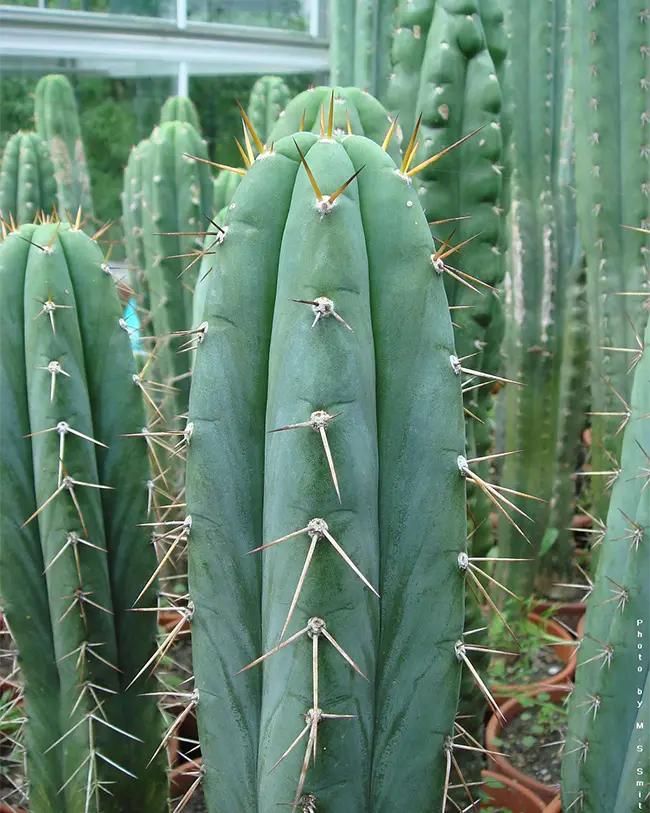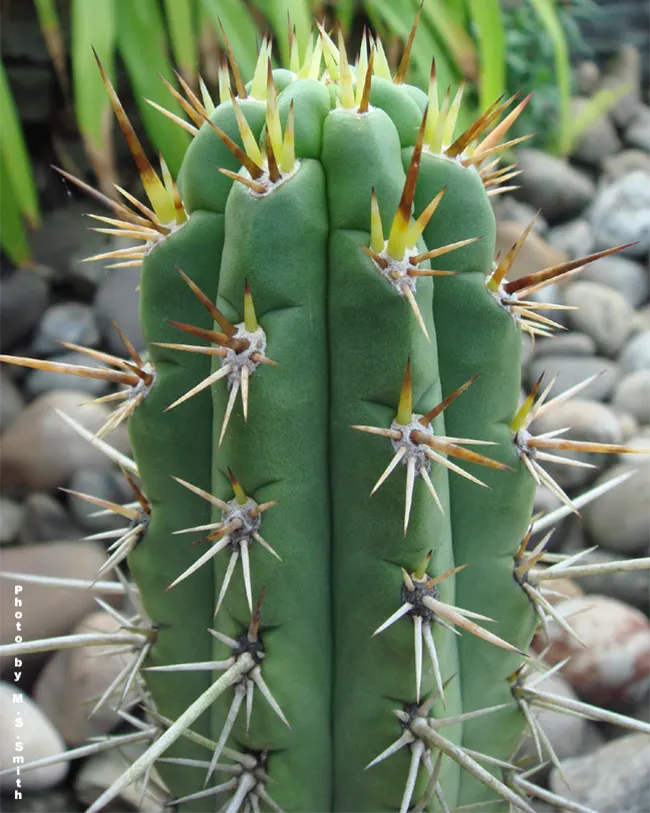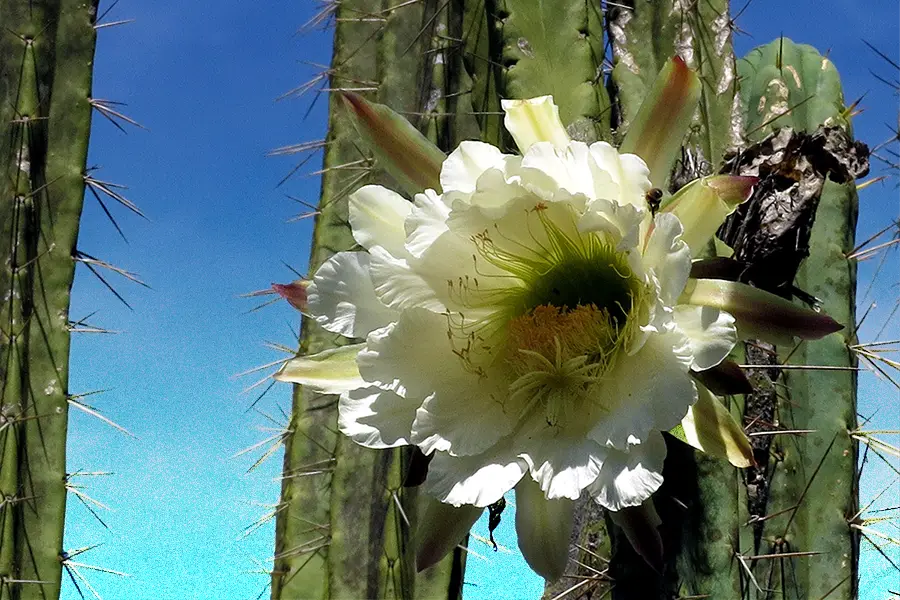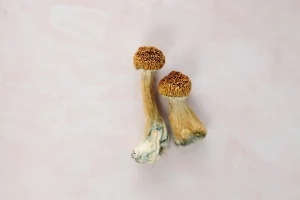When Peruvian Torch grows tall enough, it topples, scattering chunks of mescaline-containing cactus over bare rocks of the high Andes. Before long, roots shoot out, and the cactus sends horizontal projections over cliffs in search of new opportunities. Some affectionately call these ancient beings “dragons,” for their green-blue, spiked serpentine limbs and legendary potency.
Peruvian Torch (Echoniopsis peruviana) is part of a group of cacti referred broadly to as “San Pedro” or “Huachuma.” Peruviana is a distinct plant and has developed a reputation over thousands of years of use in South America. Like the patchwork of traditions scattered across the peaks and valleys of the Andes, the cacti, like people, have unique personalities formed through relationships with land and humans.
Peruvian Torch is one of the more popular characters in the San Pedro family, overshadowed only by the cactus donning the “official” San Pedro name: Echoniopsis Pachanoi. Plant identification is a niche hobby, so most lump Peruvian Torch in with dozens of other columnar mescaline-containing cacti .
However, distinguishing species is important. And not because of the (unproven) rumor that the Peruvian Torch is ten times stronger than its cousins. More pressing is that Peruvian Torch, along with other San Pedro cacti are threatened—and so are the Indigenous traditions passed on through generations.
What is the Peruvian Torch Cactus?
Peruvian Torch is native to the Andes Mountains in Northern Peru. The cactus has many regional names, such as Gigantón in Ancash, Espino in Lima, or Cure in Arequipa, to name just a few. The spiky blue-green columns grow up to seven meters tall and produce large, white, sweet-smelling flowers and edible fruits. Some live over a hundred years, their bases resembling tree trunks with age.
Peruvian Torch has a long history of use in curanderismo traditions as a healing plant. Common knowledge in villages is the treatment of wounds, fever in cattle, and baldness. Other uses for the plant exist, but the knowledge isn’t shared with outsiders. However, Peruvian Torch’s reputation as a potent variety of San Pedro is no secret. Peruviana is a popular choice of curanderos for healing a huge variety of ailments, from physical, to mental, to spiritual.

The medicinal value is often attributed to Peruvian Torch’s mescaline content, but in Peru, its value is more than alkaloids. Huachumero Josip Orlovac del Rio has worked with the cactus for over 30 years. Orlovac recalls growing up his siblings getting high on the cactus, laughing in the garden or taking it to parties in Lima. “This is not a drug!” his grandfather scolded, “It is not something we use to escape.” He soon consumed the cactus as a teenager and began to study with a Northern Maestro Felipe Pereda. Orlovac continues to honor this view, explaining that if he were to ask his son to drink it, the response would be, “I don’t need to drink it, it’s medicine, and I’m not sick.”
How to Grow Shrooms Bundle
Take Both of Our Courses and Save $90!
Origins and History of Peruvian Torch
Cacti evolved some 30 to 40 million years ago when changes to the earth’s climate created a need for plants able to survive extended dry periods. South America is the birthplace of cacti, and they have been sharing the continent with humans for at least 14,800 years.
To our current knowledge, the first evidence of human relationship with sacred cacti is 3000-year-old carvings on the structures of Chavín de Huántar in Northern Peru. Ancient sites and carvings scattered around the continent show San Pedro cacti were valued and brought far beyond their natural range. Exactly what role the cacti played isn’t known. Still, stone carvings depicting half-human, half-animal creatures with San Pedro spark assumptions about the rituals of a cult or oracle.
The Chavin culture was replaced by the Incas and then the Spanish. The use of San Pedro was recorded by the Spanish upon arrival but suppressed. Across the continent, Catholic missionaries did their best to replace traditional medicine and worship with Catholicism. In most areas, they succeed, systematically undermining use. However, in the north, Orlovac assures me that pockets of curanderos still practice old ways of using cacti, with Peruvian Torch an important part of the toolkit today, specifically.

In 1914, cactus taxonomist Briton Rose collected Peruvian Torch 2100 meters in the Andes and documented the species as “peruviana” in his book, The Cacteace. Originally the genus was “Trichocereus,” but after decades of confusion, taxonomists changed the name to “Echonopsis.” In the 70s, cactus enthusiasts began extracting rare cactus genetics from remote valleys, and so began an underground psychedelic industry. Psychoactive cacti were peddled by mail: They were legal to grow but illegal to prepare in much of the Western world.
Overall, sacred cacti trade largely existed under the radar in the global North and South—until the 90s and early 2000s. The psychotourism industry exploded. The mystique of Peru brought adventurers to Cusco and the Sacred Valley, where seekers hike Machu Picchu, hoping to glimpse back in time. What better way than with a psychedelic cactus?
In the years since San Pedro, ceremonies have become staples of Peruvian expeditions and retreat experiences. The stories of healing and transformation are not easily forgotten, and understandably people are eager to share them. Now travelers bring home a unique souvenir—bags of dried cactus. The majority is Peruvian Torch. The spread of these practices threatens another long-held tradition—however well-intentioned.
Peruvian Torch vs. San Pedro
The story of “San Pedro” isn’t about a single plant. The cacti used in most ceremonies frequented by seekers in the Sacred Valley differ from what would be considered San Pedro. “San Pedro” generally refers to columnar mescaline containing cacti but is technically a specific species—Echinopsis pachanoi. Yet, pachanoi isn’t the most common find in the markets and retreats of Cusco. Conservationists estimate that most of the plant material consumed is peruviana—Peruvian Torch.
READ: Mining and Poaching Threatens 15,000-Year-Old Peyote Tradition in Mexico

Why bother with the Latin names and distinctions? Well, cactus people are constantly searching for the latest genetics, akin to cannabis strains in a dispensary. Different concentrations of alkaloids create different experiences. For years, rumors and studies have puzzled over whether Peruviana or Pachanoi is more potent—not to mention other species and subspecies like Bridgesii, Cuzcoensis, Sanantaenses, Puquiensis, and others recognized by either botanists or curanderos.
To date, lab results confirm a large variability between specimens in mescaline concentrations and other phytochemicals. Online reports said one thing; independent cactus researchers like Keeper Trout say another: Trout declared classification systems of sacred cacti “hopelessly muddled,” casting further doubt onto lab results.
How to Identify Peruvian Torch
Orlovac has been collecting and consuming San Pedro cacti for over thirty years and tending a garden of over 4,000 plants in Chaclacayo, Lima on the land were we grew up. Orlovac began the garden twenty years ago to preserve specific cacti his grandfather had introduced him to in Arequipa, which were beginning to disappear.
When I ask about identifying Peruvian Torch, he first explains to look for three to four-inch thorns—and then it quickly becomes complicated. Whether or not a cactus has spines can change botanical classification into pachanoi or peruviana categories,which sounds easy enough, but then he recounts planting a cutting of an 80-year-old Peruviana from the wild. After seven years of domestication, the thorns disappeared, and now the cactus clone to be appears as pachanoi in the eyes of many experts who assume
Keeper Trout, author of several books about cactus identification, says, “people like simple and predictable, but that only works when reality allows it.” He also notes that in plant nurseries in the United States, Peruviana is far less common than Pachanoi and often is skinnier than those found in the wild. He also mentions seedlings will look nothing like an adult, being green with weaker spination than adults. Trout says, “look at a lot of pictures and ideally also live plants.” He reassures me it gets easy with practice while also adding that peruviana is “grandfathered and lacks what is considered acceptable for a description today.” Such a botanical description would distinguish between sterile plants and might include flowers, fruit, or phytochemicals.
After summarizing where to find all the Echonipsis in Peru off the top of his head, Orlovac adds with a laugh, “As curanderos, we don’t care if it’s Pachanoi or Peruviana. It doesn’t exist for us.” He explains that botanists aren’t creating classifications around medicinal value like curanderos do. Botanists often choose a name based on a region. “For us,” he says, “we have ‘macho’ for those with spines and ‘hembra’ for those without.” And because one can find macho and hembra across many regions, he sums up, “you need to know your plants,” noting the abundance of non-mescaline-containing look-alikes.
For Orlovac, knowing plants isn’t about botanical names. For him, it’s a relationship, not to a name but a spirit, along with the mountains, valleys, and lakes where it comes from. For those who know plants, Latin names and alkaloids are never the whole story.
Psychoactivity of Peruvian Torch and San Pedro
Laurel Anne Sugden is a Ph.D. Candidate of Interdisciplinary Studies at UBC. She is also Orlovac’s wife. When I ask her the difference between San Pedro and Peruvian Torch, she tells me how Peruvian Torch (E. Peruvianus) is “deeper, more emotional, more electric, and darker,” quickly adding, “but not negative.” Sugden’s background is in molecular biology and research into the bio-cultural significance of Huachuma. Not the typical answer from a researcher, and it’s undeniable how much more it says about a plant than the distance between cactus areoles.
How to Grow Shrooms Bundle
Take Both of Our Courses and Save $90!
She then describes San Pedro (E. Pachanoi) as “full of light, joyful, beautiful, sensual, sparkly and joyful.” When I ask about mescaline, she responds that Peruvian Torch is often stronger, “even if someone doesn’t know how to cook it.”
Some published research favors San Pedro over Peruvian Torch regarding mescaline content. Keeper Trout confirms this but adds, “even when correctly identified, some peruviana are good mescaline containers, and others are not.” He explains, “botanists do not presently differentiate between the chemical races that appear to exist with peruviana.”
Regarding psychoactivity, Trout cautions we don’t even have a strong understanding of how mescaline works, not to mention other unstudied alkaloids present in high concentrations in some cacti. “This area needs to be worked out in a multidisciplinary way involving both botanists and chemists,” he says.
Orlovac points out that a phytochemistry sample tells us as much about a plant as blood samples do about a human. He then speaks from innumerable sessions of drinking sacred cacti, unpacking the nuances of using the cactus dosed carefully for various healing processes. While he acknowledges San Pedro as potent, he also states that Peruvian Torch is the strongest. He says one must be prepared to “ride the dragon” over the Andes while bringing specific attention to the Peruvian Torch’s ability to bring visions, an energetic cleansing of the body, and a connection to emotions and traumas.
Peruvian Torch Conservation
Despite its reputation, Peruvian Torch is affected by pressures any plant faces in the modern world: Cattle grazing, roads, mining, and climate change, which interrupts the delicate water requirements of the plant.
But there is extra pressure on Peruvian Torch: The cactus is a top choice among psychonauts because it’s thought to be more potent. Facilitators and retreat centers consume huge, but unknown quantities each year, and the Peruvian Ministry of Environment has issued a report on the export industry’s legal export of the cacti being 40 tons between 2009-2013. Current numbers on illegal export are also unknown. The report also lists both Peruvian Torch and San Pedro as “endangered,” but the Peruvian government has put no regulations in place.
Many locals with limited economic opportunities no longer use cacti as medicine. For them, a few dollars is worth the labor-intensive process of cutting and processing the plants into powder and bringing them to local markets, where vendors sell it for as low as a few dollars per kilogram. Some buy it as a travel souvenir. Others purchase the cacti in bulk for export. The nondescript green powder is marked as “cactus flour,” “sea shells,” or with the names of local herbs like “organic aloe vera.” The packs slip easily through customs and can be flipped online for hundreds of dollars per kilogram. Other powder ships direct to facilitators running ceremonies around the world.
Back in Peru, Orlovac recalls one traditional maestro dying in poverty of tuberculosis in the northern part of the country. The communities where the cacti grow natively have no schools, books, or healthcare. Orlovac contrasts this with facilitators in the United States, some easily clearing $1000 per ceremony, with not a cent returning to the people, culture, and land producing the medicine. “It is outside of balance,” he says, adding, “something that we learn from San Pedro is balance.”
Texting via Signal, an anonymous facilitator in the United States explains she gives individual San Pedro sessions for “comfort through grieving, to open my heart and keep it open” and, she says, “to strengthen my ability to love and be loved.” She tells me how to order cacti online describing photos in the catalog of thousands of cacti growing in nurseries in the sunshine of the Western states. “A lot are family owned” she says, “and the kids help.”
Distributors grow famous genetics from seeds gathered in South America in the 1900s. A potted cactus can arrive in the mail and she tells me distributors say there is an “adequate supply.” Owning the plants is legal in the states, but unless in an area of decriminalization, are illegal to process.
The Ethical Use of Sacred Cacti
Over a WhatsApp from a noisy cafe in Lima, Orlovac emphasizes to me that the real trick to working with sacred cacti isn’t counting alkaloids but a real relationship with the plant, land, and lineage supporting it. When I dig deeper about knowing a plant, Sugden explains its spirit comes from the land it grows on, its relationship with the soil, hummingbirds, and bees, and how well it is loved. She emphasizes relationships between plants and people are reciprocal. And while it is clear that sacred cacti have much to teach, Orlovac adds, “the plant is open to learning from us,” too.
Orlovac, Sugden, and Felipe Pereda Llanos, a Chimbote and Coishco curandero, co-founded Huachuma Collective to establish the relationship between plants and people. Sugden explains in the organization’s newsletter that some try to “save” the plants by disconnecting from them entirely. She acknowledges sustainability motives are noble, but abstinence from the plant, commercial monocultures, or synthetic mescaline do not facilitate a reciprocal relationship. “Reciprocity is not a one-way street,” she says.
When harvesting in the wild, huachumeros make offerings of prayers to the lakes and mountains with coca, flowers, and chicha. Outside homes, the plant has long been respected as a protector and bringer of good fortune. Huachuma Collective is clear:
“It has never been our goal, in advocating for the wild plants, to discourage people from drinking the medicine. Quite the opposite: drinking the medicine and listening to the plant is one of the best ways to shatter the illusion of human supremacy and disconnection from nature.”
Instead of calling for a stop to cactus consumption, Huachuma Collective has pledged to plant one million cacti. As a non-profit, donations fund the project, which supports plants and education in Andean communities. The bio-cultural initiative seeks to regenerate not only plants but the value of the plants in communities for economic and spiritual growth.
The team donate ready-to-plant cacti to the partner communities El Castillo, Barbaco, Chankillo, and Tortugas Beach in Northern Peru. Pereda runs workshops and shares his gifts—one person might seek Pereda’s skill for relief from back pain, or another request he attends an aging elder. The process, they say, unravels the stigma against curanderismo and values the craft in the eyes of youth while young cacti find homes in their native land.
“Cultivation is the solution,” says Sugden. Anyone can have a relationship with San Pedro growing on their windowsill in a pot. She urges, “Every person who drinks San Pedro should grow the plant if they have the opportunity.”
Orlovac calls for practitioners to have the patience to grow their own, “grow medicine, serve medicine,” he says. Orlovac studied for 20 years before serving San Pedro, which is plenty of time for a garden to mature. For people seeking ceremonies, Huachuma Collective suggests choosing traditionally trained Peruvian curanderos working with sustainably sourced plants.
Huachuma Collective also calls for the boycott of dried powder. It lacks the full experience of the plant. The powder is an endangered and unprotected sacred plant. The extractive process is illegal and gives nothing back to Peruvian communities in extreme poverty.
Wild San Pedro cactus as a sustainable source of mescaline is a myth, and the remaining habitat is shrinking daily. Sharing this information matters, but ultimately Huachuma Collective’s vision involves skin in the game—rebuilding relationships with hands in the dirt growing cacti. As Sugden reminds us, “we cannot truly protect another being until we love them, and we cannot love them until we know them.”
A note from the author: If you have a love for San Pedro and Peruvian Torch, donate here and follow Huachuma Collective on Instagram.
*The perspectives represented in this article do not necessarily reflect those of DoubleBlind.
Interested in having a psychedelic experience, but don't know where to start? Get our definitive guide on trusted legal retreat centers, clinical trials, therapists, and more.
We started DoubleBlind two years ago at a time when even the largest magazines and media companies were cutting staff and going out of business. At the time we made a commitment: we will never have a paywall, we will never rely on advertisers we don’t believe in to fund our reporting, and we will always be accessible via email and social media to support people for free on their journeys with plant medicines.
To help us do this, if you feel called and can afford it, we ask you to consider becoming a monthly member and supporting our work. In exchange, you'll receive a subscription to our print magazine, monthly calls with leading psychedelic experts, access to our psychedelic community, and much more.



